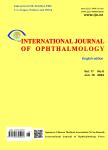Comparison of lens oxidative damage induced by vitrectomy and/or hyperoxia in rabbits
Comparison of lens oxidative damage induced by vitrectomy and/or hyperoxia in rabbits作者机构:Department of OphthalmologyTangdu HospitalFourth Military Medical UniversityXi'an 710038Shaanxi ProvinceChina Chongqing Key Laboratory of OphthalmologyChongqing Eye Institutethe First Affiliated HospitalChongqing MedicalUniversityChongqing 400016China Department of MicrobiologyFourth Military Medical UniversityXi'an 710032Shaanxi ProvinceChina Department of OphthalmologyShaanxi Provincial People's HospitalXi'an 710068Shaanxi ProvinceChina Department of Clinical MedicineXi'an Medical UniversityXi'an 710021Shaanxi ProvinceChina Department of NeurosurgeryTangdu HospitalFourth Military Medical UniversityXi'an 710038Shaanxi ProvinceChina
出 版 物:《International Journal of Ophthalmology(English edition)》 (国际眼科杂志(英文版))
年 卷 期:2017年第10卷第1期
页 面:6-14页
核心收录:
学科分类:1002[医学-临床医学] 100212[医学-眼科学] 10[医学]
基 金:Supported by National Natural Science Foundation of China(No.30872837)
主 题:nuclear sclerotic cataract vitrectomy hyperoxia lens oxidative insult
摘 要:AIM: To compare of lens oxidative damage induced by vitrectomy and/or hyperoxia in ***: Sixteen New Zealand rabbits (2.4-2.5 kg) were randomly divided into two groups (Group A, n=12; Group B, n=4). In Group A, the right eyes were treated with vitrectomy and systemic hyperoxia (oxygen concentration: 80%-85%, 1 ATA, 4h/d) (Group A-right), and the left eyes were treated with hyperoxia without vitrectomy surgery (Group A-left). Four rabbits in group B (eight eyes) were untreated as the controls. Lens transparency was monitored with a slit lamp and recorded before and after vitrectomy. After hyperoxic treatment for 6mo, the eyeballs were removed and the lens cortices (containing the capsules) and nuclei were separated for further morphological and biochemical ***: Six months after treatments, there were no significant morphological changes in the lenses in any experimental group when observed with a slit lamp. However, the levels of water-soluble proteins and ascorbate, and the activities of catalase and Na+-K+-ATPase were significantly reduced, whereas the levels of malondialdehyde and transforming growth factor β2 (TGF-β2) were significantly elevated, in both the cortices and nuclei of eyes treated with vitrectomy and hyperoxia. The increase in protein-glutathione mixed disulfides and the reduction in water-soluble proteins were more obvious in the lens nuclei. The levels of ascorbate in the vitreous fluid were also reduced after vitrectomy, whereas TGF-β2 increased after vitrectomy and hyperoxia. Systemic hyperoxia exposure increased these effects. CONCLUSION: Removal of the intact vitreous gel with vitrectomy and exposing the lens to increased oxygen from the retina induce lens oxidation and aggregation. Thus, an intact vitreous gel structure may protect the lens from oxidative insult and maintain lens transparency.



